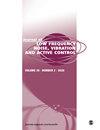Influences of wheel polygon amplitude on wheel-rail vibration and sound radiation
IF 2.4
4区 工程技术
Q1 ACOUSTICS
Journal of Low Frequency Noise Vibration and Active Control
Pub Date : 2023-01-20
DOI:10.1177/14613484231152850
引用次数: 1
Abstract
Wheel polygon amplitude can greatly affect wheel-rail vibration and sound radiation. Based on multi-body dynamics theory, a vehicle-track rigid-flexible coupling dynamics model was established. According to the actual running wear condition of the wheel, the wheel-rail vibration response was calculated and analyzed (the order of wheel polygons is 20, and the polygon amplitude is 0.01/0.02/0.03/0.04 mm, respectively). Together with the finite element/boundary model of the wheel, the calculated wheel-rail force was used as an external incentive to analyze the effects of polygon amplitude on the time-frequency domain of wheel noise. The research results show that: when the polygon order is 20, with the increase of polygon amplitude, the wheel-rail vertical force and the acceleration of wheel, rail and track slab increase gradually. It’s also found that the rail acceleration is obviously more sensitive to the amplitude than the track slab acceleration, while the vertical displacement of the rail and track slab is less sensitive to the polygon amplitude. At the same amplitude, the closer to the wheel rolling line, the more obvious the sound pressure decreases with the increase of height. At different amplitudes, the sound pressure at different positions will increase with the rise of the polygon amplitude. The root mean square value of sound power increases gradually with the addition of amplitude: When the amplitude changes from 0.01 mm to 0.04 mm, the calculated sound power increases by 4.1 dB.车轮多边形幅值对轮轨振动和声辐射的影响
车轮多边形幅值对轮轨振动和声辐射有较大影响。基于多体动力学理论,建立了车辆-轨道刚柔耦合动力学模型。根据车轮实际运行磨损情况,计算分析轮轨振动响应(车轮多边形阶数为20,多边形幅值分别为0.01/0.02/0.03/0.04 mm)。结合车轮有限元/边界模型,将计算得到的轮轨力作为外部激励,分析了多边形幅值对车轮噪声时频域的影响。研究结果表明:当多边形阶数为20时,随着多边形幅值的增大,轮轨垂直力和轮轨、轨板的加速度逐渐增大;钢轨加速度对振幅的敏感性明显高于轨板加速度,而轨板垂直位移对多边形振幅的敏感性较低。在相同振幅下,越靠近车轮滚动线,声压随高度的增加而减小越明显。在不同振幅下,不同位置的声压会随着多边形振幅的增大而增大。声功率均方根值随幅值的增加而逐渐增大,幅值从0.01 mm变化到0.04 mm时,计算声功率增加4.1 dB。
本文章由计算机程序翻译,如有差异,请以英文原文为准。
求助全文
约1分钟内获得全文
求助全文
来源期刊

Journal of Low Frequency Noise Vibration and Active Control
Engineering-Mechanical Engineering
CiteScore
4.90
自引率
4.30%
发文量
98
审稿时长
15 weeks
期刊介绍:
Journal of Low Frequency Noise, Vibration & Active Control is a peer-reviewed, open access journal, bringing together material which otherwise would be scattered. The journal is the cornerstone of the creation of a unified corpus of knowledge on the subject.
 求助内容:
求助内容: 应助结果提醒方式:
应助结果提醒方式:


